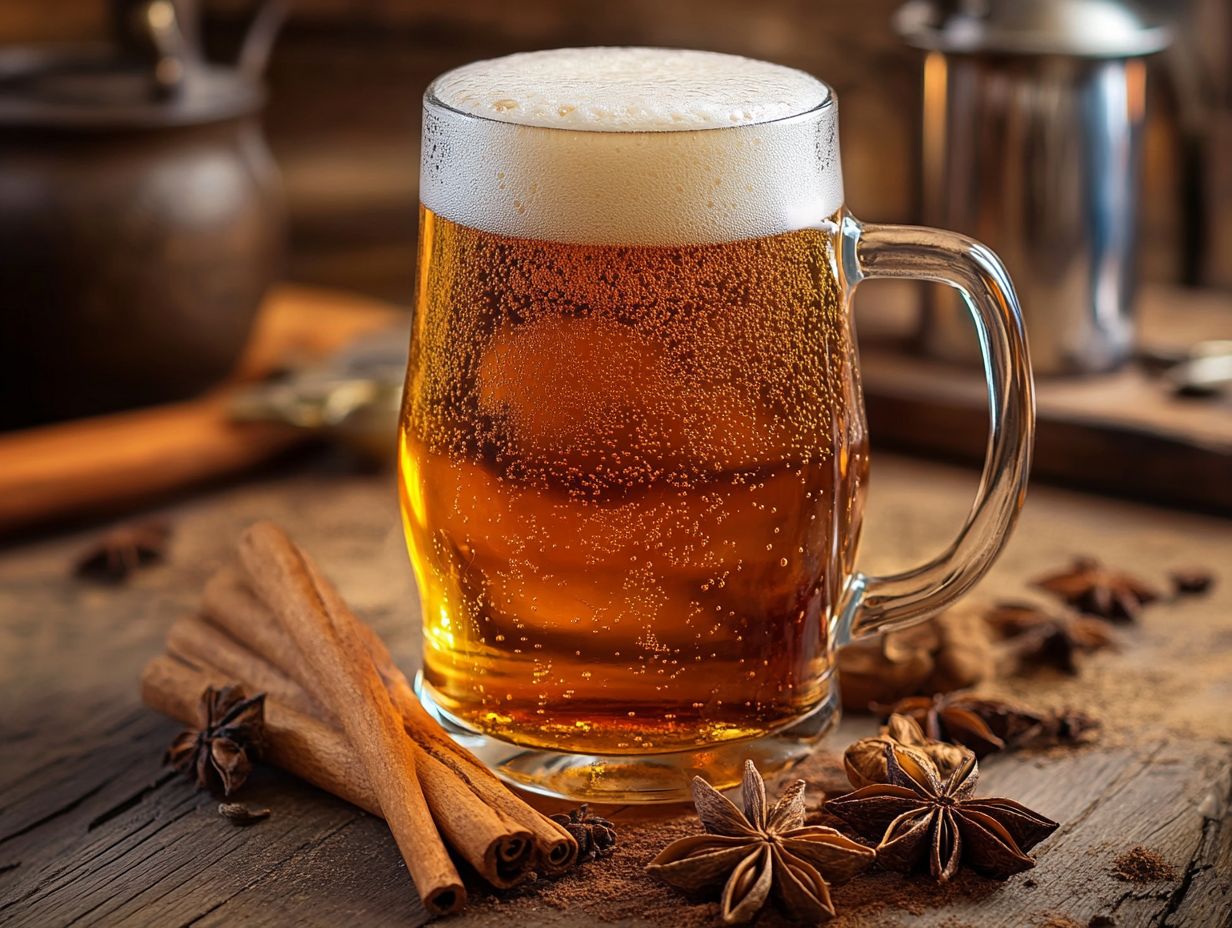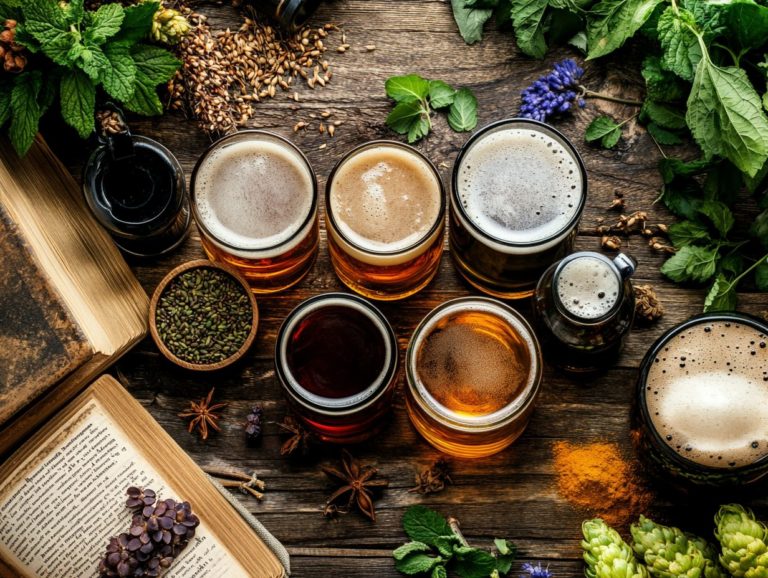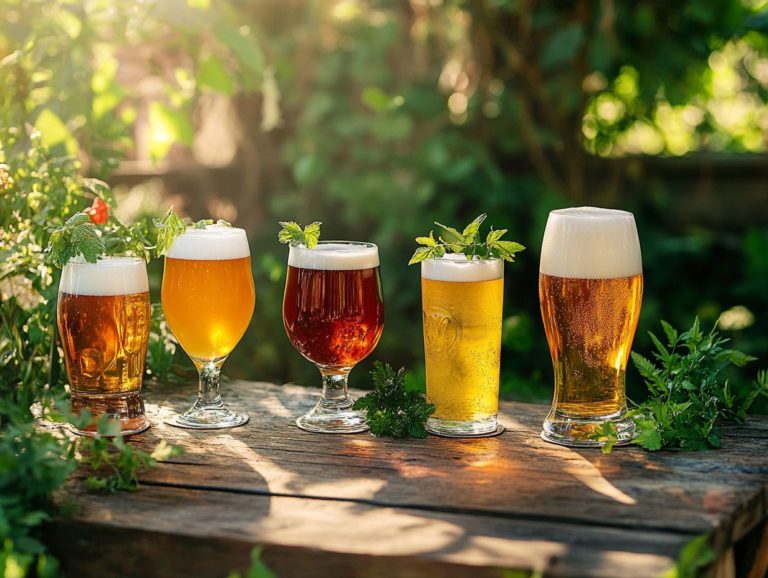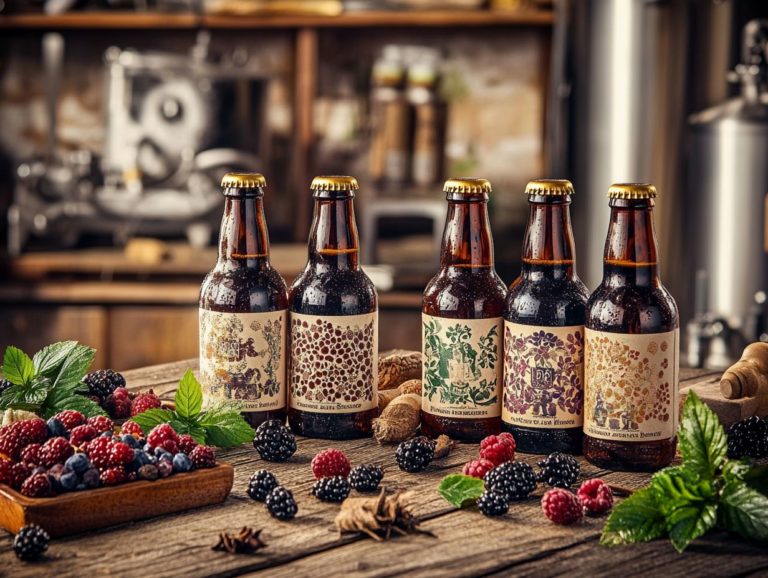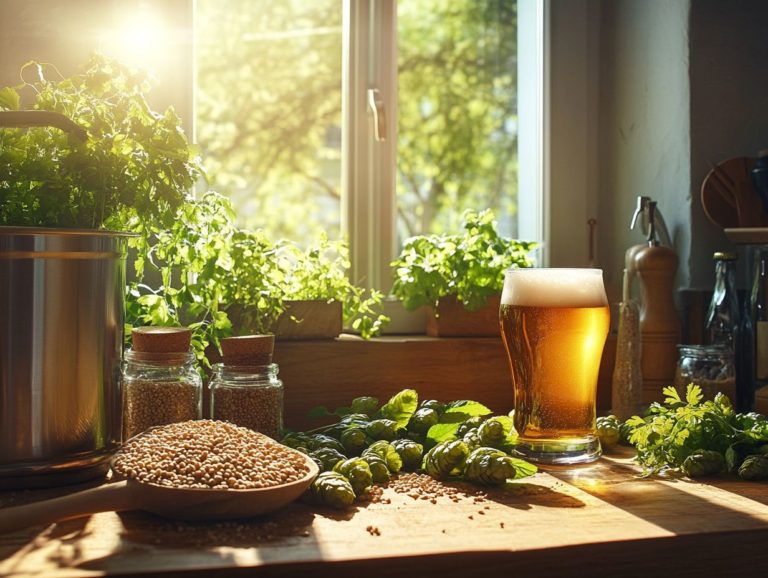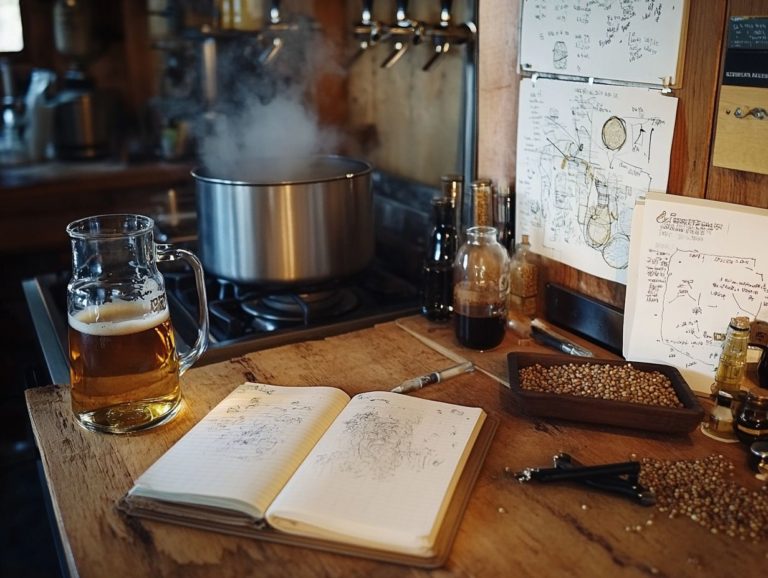Crafting Unique Beer Recipes with Spices
Spices have long been a captivating ingredient in the brewing world, adding depth and character to beers that elevate them from the ordinary to the extraordinary.
This article delves into the rich history of spices in beer, highlighting how they can enhance flavors and the nuances involved in selecting the perfect ones for your brewing endeavors.
Whether you re an experienced brewer or a curious newcomer, you ll discover valuable tips and methods for incorporating spices into your recipes, encouraging you to unleash your creativity and craft uniquely flavorful brews.
Contents
- Key Takeaways:
- The History of Using Spices in Beer
- How Spices Can Enhance Beer Flavors
- Choosing the Right Spices for Your Beer Recipe
- Methods for Incorporating Spices into Beer Recipes
- Creating a Spice Tincture
- Dry Spicing in Secondary Fermentation
- Tips for Using Spices in Beer Recipes
- Exploring Creative Brewing Techniques
- Frequently Asked Questions about Craft Beer and Spice Additions
- What are some common spices used in crafting unique beer recipes, including pumpkin-infused beers?
- How do spices and ingredients such as citrus hops affect the flavor of beer?
- What are some tips for incorporating spices and achieving flavor balance in beer recipes?
- Are there any traditional or seasonal beer styles that use spices?
- Can spices be added during the brewing process or only during fermentation or dry-hopping process?
- Are there any potential risks or challenges to using spices in beer recipes?
Key Takeaways:
The History of Using Spices in Beer
The history of using spices in beer is both rich and varied, inviting you to explore how culinary artists over the ages have pushed the boundaries of flavor. Throughout time, they ve experimented with unique combinations to create spiced beers that truly tantalize the palate.
From the ancient practices of brewing with winter spices to today s modern revival of pumpkin-infused seasonal brews, spices have played an essential role in shaping diverse beer styles. Ingredients like star anise and mulling spices contribute not only complexity but also significantly influence the brewing process, affecting everything from the malt grain bill to the final flavor profiles of craft beer.
How Spices Can Enhance Beer Flavors
Spices have the remarkable ability to enhance beer flavors, introducing unique combinations that elevate your brewing experience and create truly palate-pleasing brews.
By thoughtfully selecting spices and achieving a harmonious balance with hops and malt, you can craft a complex flavor profile that distinguishes your spiced beers in a competitive craft beer market.
Whether you choose to infuse citrus hops for a refreshing zing or incorporate winter spices to evoke a cozy seasonal ambiance, the right blend can turn an ordinary beer recipe into an extraordinary tasting experience that delights the senses.
1. Adding Depth and Complexity
Adding depth and complexity to spiced beers is truly an art form that calls for your keen understanding of brewing techniques and ingredient selection. By incorporating various spices into the brewing process think star anise or seasonal favorites like nutmeg and cinnamon you can craft intricate flavor profiles that captivate the senses and enhance the overall drinking experience.
The interplay between these spices and the base malt can significantly elevate your final product, often creating a unique synergy that amplifies the overall alcohol by volume. Picture a traditional pumpkin ale; it might seamlessly blend the soft sweetness of caramel malts with the warming spice of ginger, crafting a balance that invigorates the palate while showcasing the beer’s robust character.
Consider, too, a winter warmer spiced with clove or cardamom. This combination evokes the essence of the season, demonstrating how thoughtfully chosen ingredients can elevate a beer from mere refreshment to a truly memorable experience.
Successful recipes often highlight how complexity in flavor can attract diverse palates, reflecting the growing appreciation for innovative brewing methodologies.
2. Balancing Sweetness and Bitterness
Balancing sweetness and bitterness in your beer recipe is essential for crafting a harmonious flavor profile that appeals to a diverse range of palates. By thoughtfully selecting the right combination of hops, like Citra or Mosaic, and strategically incorporating winter spices at various stages of the brewing process, you can create a well-rounded beer that beautifully balances both sweetness and bitterness.
The fermentation temperature is a key player in this delicate dance. Higher fermentation temperatures can amplify fruity esters while softening bitterness, which is especially advantageous for styles like New England IPA (NEIPA) that thrive on juicy, hop-forward characteristics.
On the other hand, lower temperatures are often preferred for traditional styles such as Saison, where a crisp finish and spicy notes are paramount. Timing your spice additions is also crucial; adding spices early in the boil extracts bold flavors, while later additions preserve those subtler aromas, allowing for nuanced layers of complexity that elevate the overall taste profile of your beer.
3. Creating Unique Aromas
Creating unique aromas in beer is an important part of brewing that can greatly influence your overall tasting experience. By carefully selecting specific spices and hops, you can craft distinctive flavor profiles that not only delight the palate but also enchant the senses with their aromatic qualities.
The thoughtful selection of ingredients, such as coriander or orange peel, can elevate a standard brew into an aromatic masterpiece. Take, for example, Belgian-style witbiers; they often showcase spices like coriander and curacao orange peel, producing a bright and zesty aroma that beautifully complements their refreshing flavors.
On the other hand, brews like Lagunitas IPA harness hops such as Citra and Mosaic to deliver vibrant scents of citrus and tropical fruits, further enhancing your drinking experience. This meticulous approach to recipe testing allows you to experiment with various combinations, ensuring that the final product not only satisfies your taste buds but also captivates your nose, making the beer memorable long after the last sip.
Choosing the Right Spices for Your Beer Recipe
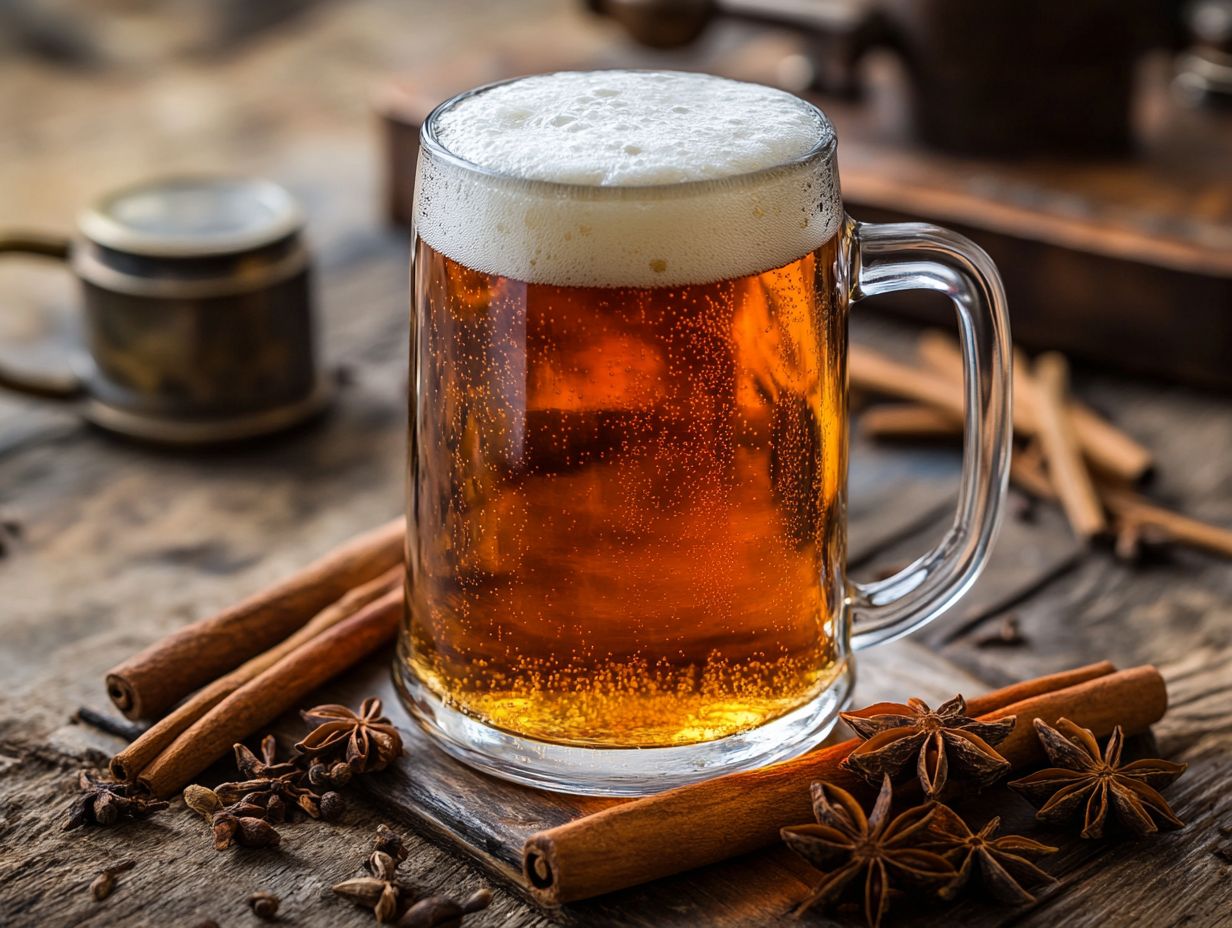
Choosing the right spices is a game changer in brewing. Selecting the right spices for your beer recipe is a pivotal moment in the brewing process that can truly elevate or undermine your final product. By mastering the art of choosing spices that harmonize with the existing flavor profiles of your base beer, you unlock the potential for extraordinary flavor experiences.
Don’t shy away from experimenting with unique combinations; this is where the magic of flavor experimentation lies. Consider the seasonal availability of ingredients to enrich your brewing journey, particularly when you re crafting seasonal beers infused with the warm, inviting spices of autumn or the comforting notes of winter.
1. Understanding Flavor Profiles
Understanding flavor profiles is crucial for you as a brewer aiming to craft spiced beers that truly stand out in the vibrant craft beer scene. By examining how different ingredients interact, you can pinpoint flavor notes that harmonize beautifully, leading to unique tastes that elevate the overall drinking experience.
To effectively analyze these profiles, it s essential to consider the specific characteristics of various hops and spices. Hops offer bitterness and a spectrum of aromas, ranging from floral to citrusy or earthy. When you combine these hops with spices like coriander, ginger, or cinnamon, you can create intricate layers of flavor that resonate with discerning palates.
Tasting small batches alongside a scoring system can provide valuable insights into which combinations succeed and which fall flat. Don’t shy away from experimenting with different ratios and timing of ingredient additions during the brewing process. This experimentation will help you perfect a signature profile that captivates beer lovers and keeps them coming back for more.
Methods for Incorporating Spices into Beer Recipes
Incorporating spices into your beer recipes opens up a world of flavor possibilities. The methods you choose can dramatically shape the final profile of your brew.
Whether you decide to add spices during the boil or explore techniques like creating a spice tincture or dry-spicing during the next brewing step, each approach brings its own set of benefits.
These choices play a crucial role in achieving the perfect flavor balance in your finished product, elevating your brewing experience to new heights.
1. Adding Spices during the Boil
Adding spices during the boil is a time-honored technique. It enables you to infuse your beer recipes with rich, complex flavors while achieving a harmonious balance. By incorporating spices like star anise or cinnamon at different stages of the boil, you can extract essential oils that significantly enhance the beer s aroma.
This method enriches the depth of flavor and influences the beer s mouthfeel and finish. Timing is crucial; if you add spices early in the boil, you’ll achieve a more pronounced flavor presence. Later additions can introduce subtler notes that won t overshadow the base profile.
Measuring your spice quantities is vital. Too much spice can easily dominate the brewing process, masking the carefully selected ingredients you’ve chosen. For optimal results, start with small amounts about one to two ounces for a five-gallon batch and adjust according to your desired intensity. This approach gives you greater control, ensuring a balanced and rewarding experience for anyone who savors your final product.
2. Considering Seasonal Availability
When selecting spices, considering seasonal availability can significantly enhance the allure of your craft beer, especially during the fall and winter months. Flavors like pumpkin and other seasonal spices are highly coveted. By incorporating these ingredients, you can craft beers that resonate deeply with consumers and truly capture the essence of the season.
This strategic approach enriches your beer s flavor profile and creates a distinctive selling point that sets your brew apart in a crowded market. For instance, beers infused with cinnamon, nutmeg, and vanilla evoke warm, cozy feelings that perfectly complement those chilly evenings. Variations like gingerbread stouts or spiced porters tap into that nostalgic holiday spirit.
Embracing popular seasonal offerings, such as pumpkin ales or winter warmers, allows you to showcase your creativity while capitalizing on consumer trends. Boost your sales and captivate your audience with unique flavors!
3. Experimenting with Different Combinations
Experimenting with different combinations of spices is an essential part of your creative brewing journey. This process enables you to uncover unique flavors and elevate your spiced beers. By testing various spice additions, you can refine your recipes and craft standout beers that will surprise and delight your customers.
Your process often begins with selecting a base beer style that beautifully complements the spices you ve chosen, whether it s a rich stout or a refreshing wheat ale. From there, brew small batches, employing techniques like steeping spices during the boil or introducing them during the next brewing step to really highlight those distinct flavors.
Meticulously documenting each variation is crucial. You ll want to note the quantities and types of spices used, along with your tasting notes and feedback from trusted tasters. For example, imagine crafting a delightful chai-spiced stout blend that includes:
- Cinnamon
- Cardamom
- Ginger
These spices harmoniously balance the malt’s sweetness. Meanwhile, a citrus-infused IPA might feature:
- Zesty coriander
- Dried orange peel
These ingredients can elevate its hoppy profile to new heights. By maintaining detailed records of your experiments, you re not just refining your craft; you re ensuring that each new creation pushes the boundaries of flavor, making your brewing journey all the more exciting.
Creating a Spice Tincture
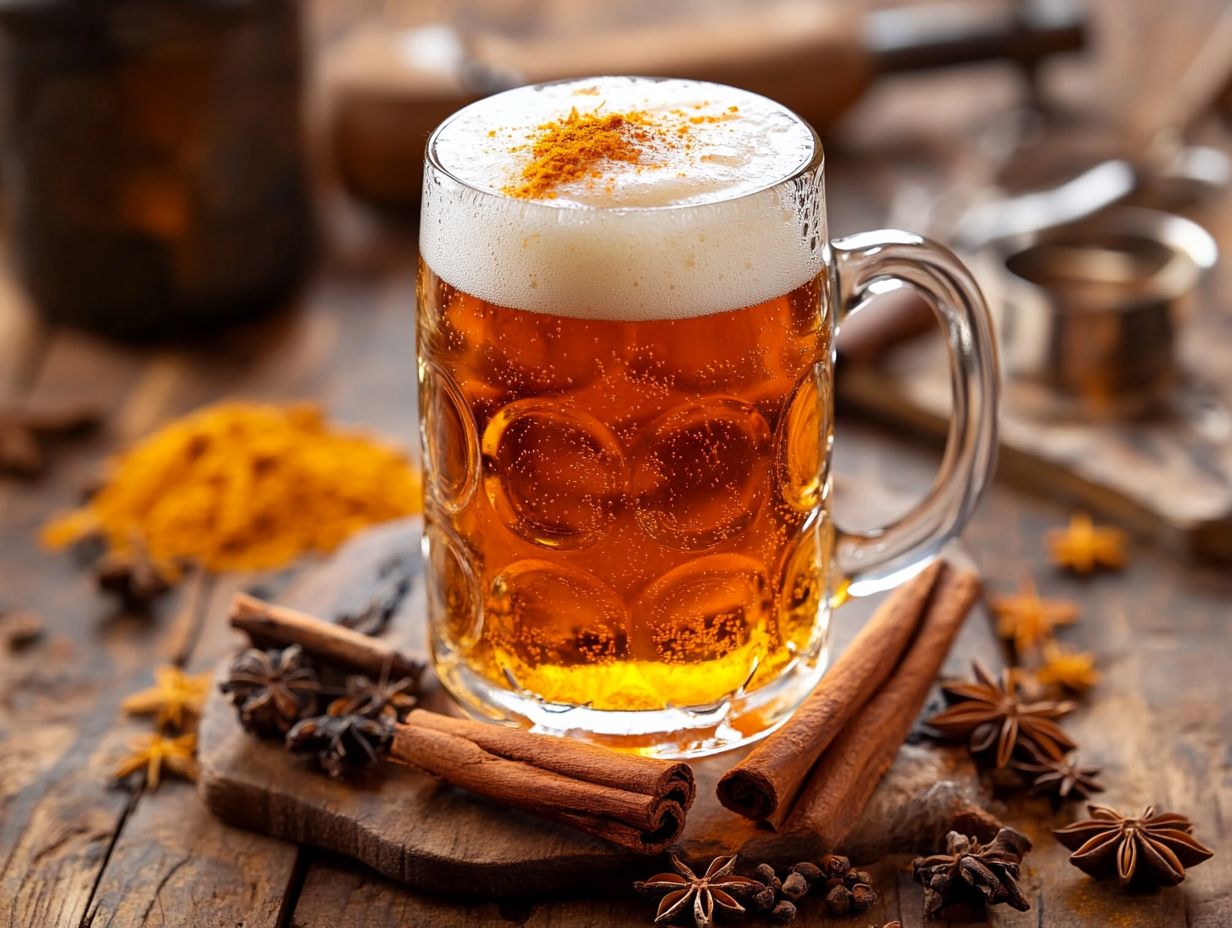
Creating a spice tincture is a game-changing brewing technique. It gives you precise control over the flavor profiles and aromas in your beer recipes.
By steeping spices in strong alcohol, like vodka or rum, you can extract concentrated flavors to enhance your finished beer without overpowering its overall alcohol by volume.
Selecting the right spices is very important for achieving your desired taste. Opt for freshly dried herbs or spices like vanilla beans, cinnamon sticks, or star anise. These pack a punch with their intense flavors.
It’s also crucial to choose high-proof alcohol, such as vodka or rum, which acts as an effective solvent to draw out the essential oils from the spices. During the tincture creation process, shake the mixture periodically to optimize flavor extraction.
After letting the tincture steep for at least a week, you can filter it and incorporate it into your brewing process. This will provide a subtle yet impactful boost to your beer s overall character.
As you become more familiar with this method, you ll likely find yourself enjoying the experimentation of different combinations to develop your own signature brews.
Dry Spicing in Secondary Fermentation
Dry spicing during secondary fermentation is a skillful method that allows you to infuse your beer with nuanced flavors. This won t make drastic changes to the fermentation process.
By introducing spices at this stage, you can unlock distinct flavors that evolve beautifully during the maturation phase. The result is a more refined final product.
This method also enhances the smell of your beer. Imagine the warmth and depth that spices like cinnamon, coriander, or star anise can bring. At the same time, citrus peel adds a delightful brightness and freshness.
When choosing your spices, it’s crucial to consider their potency. Start with smaller quantities typically one to two teaspoons per five-gallon batch and then adjust to your taste as you go.
For even flavor distribution, consider crushing or steeping whole spices in a small amount of alcohol before adding them to the fermenter. This approach gives you greater control over your beer’s final profile, ensuring every sip is a harmonious blend of your carefully chosen ingredients.
Tips for Using Spices in Beer Recipes
Incorporating spices into your beer recipes demands thoughtful consideration. Use a few essential techniques to achieve both successful brewing and delightful flavor profiles.
Begin by using small quantities of spices. This allows you to gauge their impact without overwhelming the brew. Maintaining meticulous notes of each experiment will prove invaluable, as these insights can elevate your brewing process.
Start with Small Amounts
When you re incorporating spices into your beer recipes, it s essential to start with small amounts. This way, you avoid overwhelming the final product and ensure a beautifully balanced flavor profile.
This approach allows you to experiment with different flavors without risking an entire batch. It also gives you the chance to adjust and refine your recipes to perfection.
Understanding how to gauge the right quantity of spices is crucial. Various beer styles can either highlight or obscure certain flavors. For instance, a light wheat beer might benefit from just a hint of coriander and orange peel, while a robust stout may require a more generous infusion of cinnamon or vanilla.
Successful spiced beers, like the Belgian Witbier, illustrate how a subtle addition of spices can elevate the overall experience. On the other hand, a spiced holiday ale often reveals rich layers of flavor when spices are thoughtfully integrated.
By adopting this careful, measured approach, you can uncover unique combinations that resonate beautifully within different beer profiles.
Don t wait start experimenting with your spices now!
2. Keep Detailed Notes
Keeping detailed notes throughout your brewing process is essential for successful brewing, especially when you re diving into spiced beers and unique flavor combinations. Document each step to easily replicate successful recipes. You ll also learn from the less successful ones, improving your craft beer creations.
As a brewing enthusiast, meticulously record the types and amounts of ingredients you use, along with fermentation times and the temperature of your brewing area. This becomes a valuable resource for future batches. Utilizing organized formats like spreadsheets or dedicated brewing apps allows you to quickly reference past brews, facilitating a more informed approach to each new experiment.
Don t overlook the importance of noting specific sensory outcomes like aroma, taste, and mouthfeel. This practice can provide deeper insights, making each brewing experience a more educational endeavor. Adopting this disciplined approach to documentation fosters your creativity and enhances your ability to innovate while maintaining quality and consistency in your craft.
3. Don’t Be Afraid to Get Creative
One of the most thrilling aspects of brewing lies in the opportunity to unleash your creativity through flavor experimentation, particularly when crafting spiced beers that flaunt unique profiles. By embracing this creative spirit, you can push the boundaries of traditional brewing techniques and discover new flavor combinations that will truly captivate your audience.
To ignite this inventive mindset, consider experimenting with unconventional ingredients like exotic spices, herbs, or even fruits that you might not typically associate with beer. For instance, incorporating elements such as cardamom, ginger, or hibiscus can yield refreshing and complex flavor profiles that set your creations apart in a bustling market.
Sharing your ideas with fellow brewers is beneficial. Engage with local communities to allow for a rich exchange of innovative approaches. Look at successful spiced beers that feature unexpected ingredients like Serrano peppers or cedar; they serve as perfect examples of how creativity can lead to delightful surprises.
Nurturing a spirit of experimentation results in memorable brews that entice both seasoned beer connoisseurs and curious newcomers alike, encouraging successful brewing through flavor experimentation and adventurous brewing.
Exploring Creative Brewing Techniques
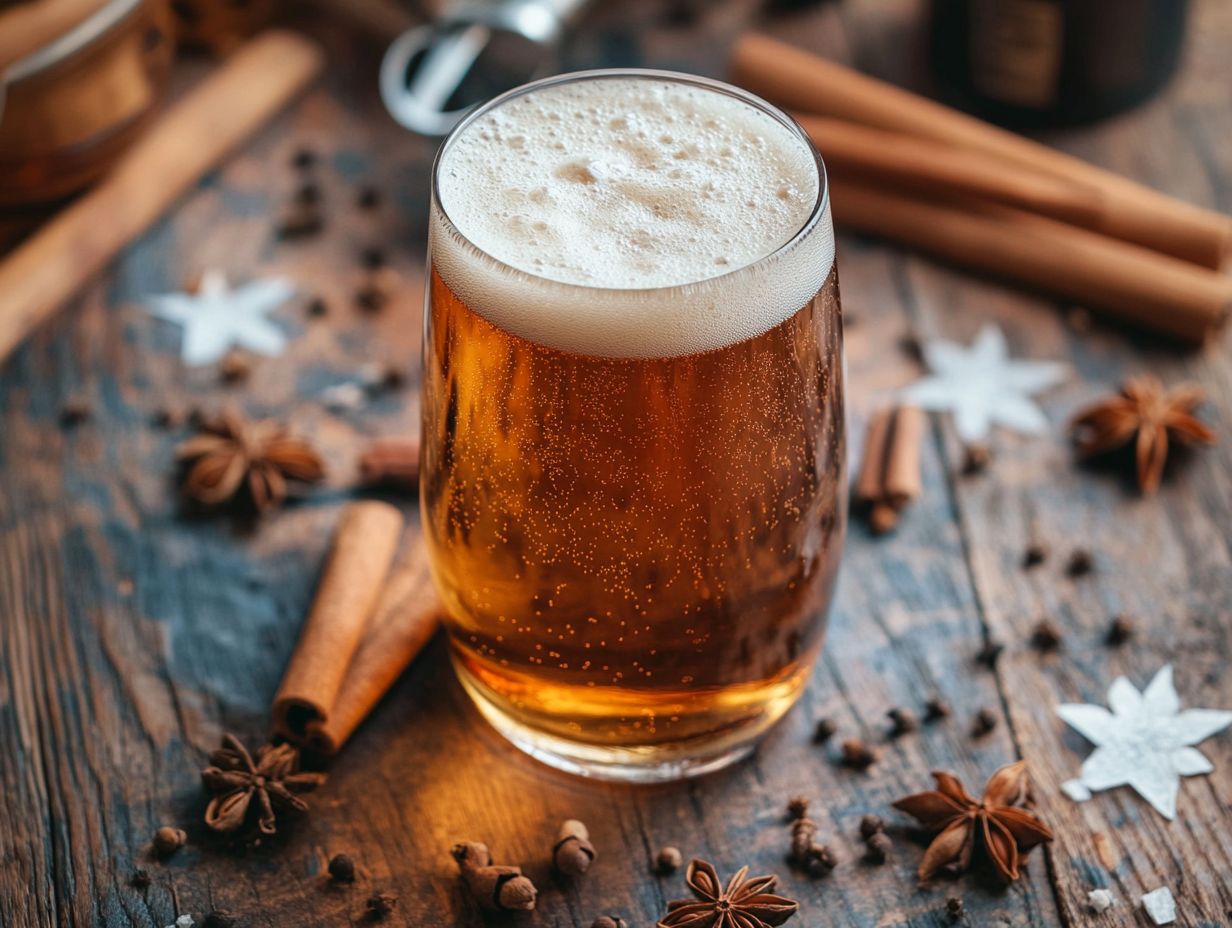
Frequently Asked Questions about Craft Beer and Spice Additions
What are some common spices used in crafting unique beer recipes, including pumpkin-infused beers?
Some common spices used in brewing beer are coriander, cinnamon, ginger, cardamom, nutmeg, cloves, and star anise.
How do spices and ingredients such as citrus hops affect the flavor of beer?
Spices can add a wide range of flavors to beer, depending on the type and amount used. They can contribute notes of warmth, sweetness, bitterness, and even citrus or floral undertones, enhancing the complexity of beer styles like NEIPA and Chai Milk Stout.
What are some tips for incorporating spices and achieving flavor balance in beer recipes?
Use spices in moderation and consider how they will interact with other ingredients in the recipe. Toasting spices before adding them to the boil can help bring out their flavors and aromas, contributing to a well-rounded malt grain bill and a balanced flavor profile.
Are there any traditional or seasonal beer styles that use spices?
Yes, some traditional beer styles that incorporate spices include Belgian witbiers, German hefeweizens, and pumpkin ales, especially during the Fall and Winter seasons.
Can spices be added during the brewing process or only during fermentation or dry-hopping process?
Spices can be added at different stages of the brewing process, depending on the desired effect. Some spices are best added during the boil, while others may be more effective when added during fermentation or even during secondary fermentation. The dry-hopping process can also introduce unique flavors from hop varieties like Citra hops and Mosaic hops.
Are there any potential risks or challenges to using spices in beer recipes?
Spices can add unique and delicious flavors to beer. However, be mindful of potential allergens or sensitivities.
Properly sanitize any spices before adding them to the brewing process to avoid contamination. Don’t forget that challenges like maintaining the right fermentation temperature and water profile are key to a successful brew!

